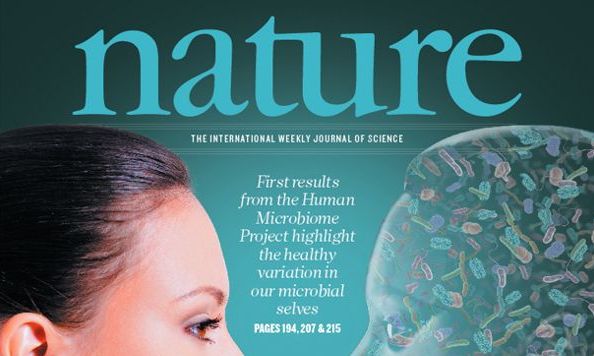| 2007年に米国国立衛生研究所(NIH; National Institutes of Health)が開始した5ヵ年計画のヒトマイクロバイオームプロジェクト(HMP; Human Microbiome Project)の研究成果が、2012年のNature誌に発表されました。 |
その健康なヒトの正常微生物群の構成がヒトマイクロオームプロジェクトによって初めて明らかにされたのです。
その結果は驚くべき知見がたくさん含まれていました。
例えば、ほとんど全てのヒトに疾患を引き起こす病原微生物が存在しているにも関わらず、病気を引き起こすことなく他の微生物の集合体と共存していることが明らかになったのです。
また、それぞれの人の微生物の構成は一人ひとりすべて異なることも分かりました。
| Structure, function and diversity of the healthy human microbiome The Human Microbiome Project Consortium Nature volume 486, pages207–214(2012) |
抄録
ヒトのマイクロバイオームの研究により、健康な個人でさえ、腸、皮膚、膣などの身体の各部位に生息する微生物の構成が著しく異なることが明らかになりました。食事、環境、宿主の遺伝学、初期の微生物への曝露がすべて関係しているとはいえ、この多様性が何によるかまだよくわかっていません。したがって、人間に関連する微生物群集の生態を特徴付けるために、ヒトマイクロバイオーム計画は、これまでで最大のコホートと、臨床的に関連のある明確な身体の生息部位のセットを分析しました。
身体の各部位における特徴的な微生物の多様性と存在量は、健康な被験者の間でも大きく異なることがわかりました。このプロジェクトでは、健康な西欧人のマイクロバイオームが占める属、酵素ファミリー、およびコミュニティ構成の推定81〜99%が見つかりました。
代謝経路のメタゲノムキャリッジは、コミュニティ構造の変動にもかかわらず、個人間で安定しており、民族/人種的背景は、経路と微生物の両方と臨床メタデータの最も強い関連の1つであることが判明しました。
したがって、これらの結果は、健康な集団の微生物群集で正常な構造的および機能的構成の範囲を描写し、ヒトのマイクロバイオームの疫学、生態学、および転移の将来の特徴付けを可能にします。
Abstract
Studies of the human microbiome have revealed that even healthy individuals differ remarkably in the microbes that occupy habitats such as the gut, skin and vagina. Much of this diversity remains unexplained, although diet, environment, host genetics and early microbial exposure have all been implicated. Accordingly, to characterize the ecology of human-associated microbial communities, the Human Microbiome Project has analysed the largest cohort and set of distinct, clinically relevant body habitats so far. We found the diversity and abundance of each habitat’s signature microbes to vary widely even among healthy subjects, with strong niche specialization both within and among individuals. The project encountered an estimated 81–99% of the genera, enzyme families and community configurations occupied by the healthy Western microbiome. Metagenomic carriage of metabolic pathways was stable among individuals despite variation in community structure, and ethnic/racial background proved to be one of the strongest associations of both pathways and microbes with clinical metadata. These results thus delineate the range of structural and functional configurations normal in the microbial communities of a healthy population, enabling future characterization of the epidemiology, ecology and translational applications of the human microbiome.
要点
この研究では、スクリーニングされ表現型が決定された242人の成人(男性129人、女性113人)からの4,788個の標本が利用可能であり、300人の対象であるヒトマイクロバイオームプロジェクト(HMP)コホートの大部分を占めています。
疾患のない成人の被験者が除外基準の長いリストに基づいて募集されました。
ここでは、コンソーシアムの臨床サンプリング基準(K. Aagaard et al.投稿された原稿)で定義されているように、それらを「正常」と呼びます。
女性は18の身体生息地で、男性は15で(3つの膣部位を除く)5つの主要な身体領域に分布しています。
口腔および中咽頭から9つの標本が採取された:唾液。頬粘膜(頬)、角質化歯肉(歯茎)、口蓋、扁桃腺、喉および舌の軟組織、歯肉上および歯肉縁下の歯垢(歯肉の上下の歯のバイオフィルム)。 2つの耳介後側の折り目(各耳の後ろ)と2つの肘前窩(内側の肘)から4つの皮膚標本と、前鼻孔(鼻孔)の1つの標本が収集されました。
自己採取した便検体は下部消化管の微生物叢を表しており、3つの膣検体が膣口、中点および後円蓋から採取されました。
マイクロバイオームの被験者内安定性を評価するために、これらのデータの131人の個人が追加の時点でサンプリングされました(平均219日とs.d.最初のサンプリングから69日、範囲35〜404日)。
品質管理後、これらの標本を454パイロシーケンシングによる16S rRNA遺伝子分析に使用しました(以降、16Sプロファイリングと省略、サンプルごとに平均5,408およびs.d. 4,605のフィルター処理されたシーケンス)。
機能を評価するために、ペアエンドのイルミナショットガンメタゲノムリードを使用して、681個のサンプルのシーケンスを行いました(サンプルあたり平均2.9ギガベース(Gb)およびs.d. 2.1ギガバイト)1。データ生成の詳細については、関連するHMP資料1および補足メソッドに記載されています。
Main
A total of 4,788 specimens from 242 screened and phenotyped adults1 (129 males, 113 females) were available for this study, representing the majority of the target Human Microbiome Project (HMP) cohort of 300 individuals. Adult subjects lacking evidence of disease were recruited based on a lengthy list of exclusion criteria; we will refer to them here as ‘healthy’, as defined by the consortium clinical sampling criteria (K. Aagaard et al., manuscript submitted). Women were sampled at 18 body habitats, men at 15 (excluding three vaginal sites), distributed among five major body areas. Nine specimens were collected from the oral cavity and oropharynx: saliva; buccal mucosa (cheek), keratinized gingiva (gums), palate, tonsils, throat and tongue soft tissues, and supra- and subgingival dental plaque (tooth biofilm above and below the gum). Four skin specimens were collected from the two retroauricular creases (behind each ear) and the two antecubital fossae (inner elbows), and one specimen for the anterior nares (nostrils). A self-collected stool specimen represented the microbiota of the lower gastrointestinal tract, and three vaginal specimens were collected from the vaginal introitus, midpoint and posterior fornix. To evaluate within-subject stability of the microbiome, 131 individuals in these data were sampled at an additional time point (mean 219 days and s.d. 69 days after first sampling, range 35–404 days). After quality control, these specimens were used for 16S rRNA gene analysis via 454 pyrosequencing (abbreviated henceforth as 16S profiling, mean 5,408 and s.d. 4,605 filtered sequences per sample); to assess function, 681 samples were sequenced using paired-end Illumina shotgun metagenomic reads (mean 2.9 gigabases (Gb) and s.d. 2.1 Gb per sample)1. More details on data generation are provided in related HMP publications1 and in Supplementary Methods.
健康な人間の微生物叢の多様性
所与の身体生息地内の微生物の多様性は、いくつかの人間の病気に関連している異なる種類の生物の数と量の分布として定義することができます:
肥満や炎症性腸疾患への腸の低い多様性、膣内から細菌性膣炎への多様性の高さ。米国の2つの異なる地理的位置にある健康なボランティアから収集された微生物群サンプルを含むこの大規模な研究では、予測された属の81〜99%に遭遇し、全体的なコミュニティ構成の範囲を飽和させて、各身体生息地で微生物コミュニティを定義しました。
口腔および便のコミュニティは、コミュニティのメンバーシップの点で特に多様であり、以前の観察を拡大しており、膣のサイトは特に単純なコミュニティを抱えていました。
この研究は、アルファダイバーシティのこれらのパターン(サンプル内)が、被験者間の同じ生息地のサンプル間の比較(ベータダイバーシティ)と著しく異なることを確立しました。
たとえば、唾液は運用分類学的単位の最高のアルファ多様性中央値(OTU、おおよそ種レベルの分類、http://hmpdacc.org/HMQCPを参照)の中にありましたが、最も低いベータ多様性の1つでした。
生態学的に豊かで、人口のメンバーは同様の生物を共有しました。
逆に、肘前窩(皮膚)は最高のベータ多様性を持っていたが、アルファ多様性の中間でした。膣のアルファダイバーシティは最も低く、属レベルではベータダイバーシティは非常に低くなっていますが、異なる乳酸桿菌種が存在するため、OTUの間では非常に高くなっています。
コミュニティ構造の変動の主なパターンは、主要な身体生息地グループ(経口、皮膚、腸、膣)に従い、結果として、ヒトの微生物叢生息地における個体群全体の対象間変動の完全な範囲を定義しました。
経時的な被験者内変動は、生体組成および代謝機能の両方において、被験者間変動よりも一貫して低かった。
したがって、個々の微生物群集の独自性は、時間の経過とともに(全体としての人口に対して)安定しているように見え、これは特に健康に関連する人間の微生物叢の別の特徴である可能性があります。
Microbial diversity of healthy humans
The diversity of microbes within a given body habitat can be defined as the number and abundance distribution of distinct types of organisms, which has been linked to several human diseases: low diversity in the gut to obesity and inflammatory bowel disease, for example, and high diversity in the vagina to bacterial vaginosis4. For this large study involving microbiome samples collected from healthy volunteers at two distinct geographic locations in the United States, we have defined the microbial communities at each body habitat, encountering 81–99% of predicted genera and saturating the range of overall community configurations . Oral and stool communities were especially diverse in terms of community membership, expanding prior observations5, and vaginal sites harboured particularly simple communities (Fig. 1a). This study established that these patterns of alpha diversity (within samples) differed markedly from comparisons between samples from the same habitat among subjects (beta diversity. For example, the saliva had among the highest median alpha diversities of operational taxonomic units (OTUs, roughly species level classification, see http://hmpdacc.org/HMQCP), but one of the lowest beta diversities—so although each individual’s saliva was ecologically rich, members of the population shared similar organisms. Conversely, the antecubital fossae (skin) had the highest beta diversity but were intermediate in alpha diversity. The vagina had the lowest alpha diversity, with quite low beta diversity at the genus level but very high among OTUs due to the presence of distinct Lactobacillus spp. The primary patterns of variation in community structure followed the major body habitat groups (oral, skin, gut and vaginal), defining as a result the complete range of population-wide between-subject variation in human microbiome habitats (Fig. 1c). Within-subject variation over time was consistently lower than between-subject variation, both in organismal composition and in metabolic function ). The uniqueness of each individual’s microbial community thus seems to be stable over time (relative to the population as a whole), which may be another feature of the human microbiome specifically associated with health.
| 歯周病の新常識 小西昭彦 阿部出版 |
歯科治療の新常識 小西昭彦 阿部出版 |

